12 Amazing Paddleboard Yoga Poses (and How to Do Them)
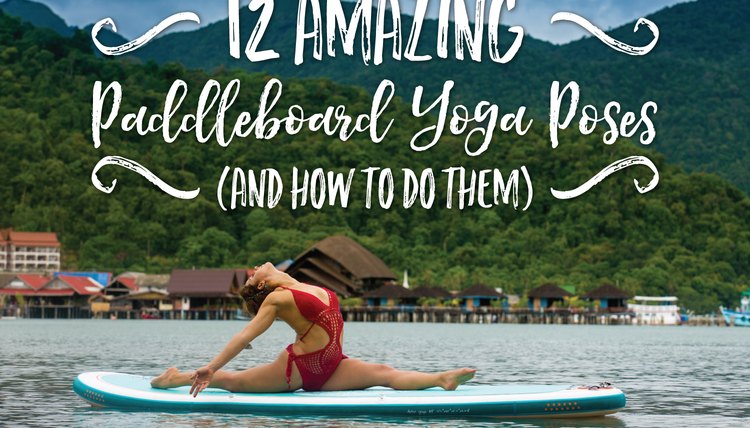
Has downward facing dog become too easy for you? Why not try doing it while balancing on a paddleboard? SUP yoga (also called paddleboard yoga) is a popular yoga-fitness fusion that involves practicing classic yoga poses while floating on a paddleboard in the middle of the water. It’s a global trend, and you can see yogis busting out poses on their paddleboards worldwide. Keep reading for 12 beautifully challenging poses along with how to do them and the benefits of each.
1. Downward-Facing Dog (Adho Mukha Svanasana)
Let's begin with the basics! This balancing, strengthening pose is widely known as a great place to start. HOW TO DO IT: Start on all fours with palms beneath shoulders and knees hip-distance apart. Spread your fingers wide, root down into the palms and place equal pressure on your fingertips and the base of your hand. Extend your arms straight. Press your chest back toward your legs as you straighten your knees and root down into the soles of your feet. Relax your neck, allowing the crown of your head to hang toward the yoga board. Take a few breaths in and out through your nose.
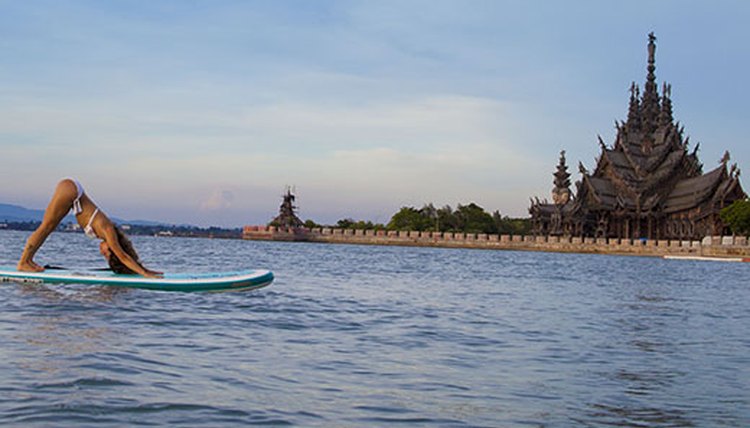
Dashama Gordon
2. Crescent Lunge (Anjaneyasana)
This pose strengthens your core and legs, stretches your hip extensors and improves your balance. HOW TO DO IT: Start with one foot forward and the other leg extended back, your front knee bent at 90 degrees. Beginners should start with hands on the board by your front foot or at least one down and one up to stabilize you until you have the core control to stay aligned on the board. The toes of your back foot should point out to the side to stabilize your body. Lift your heart and lengthen your spine while reaching up toward the sky. Hold the pose for at least five breaths, and then switch sides.
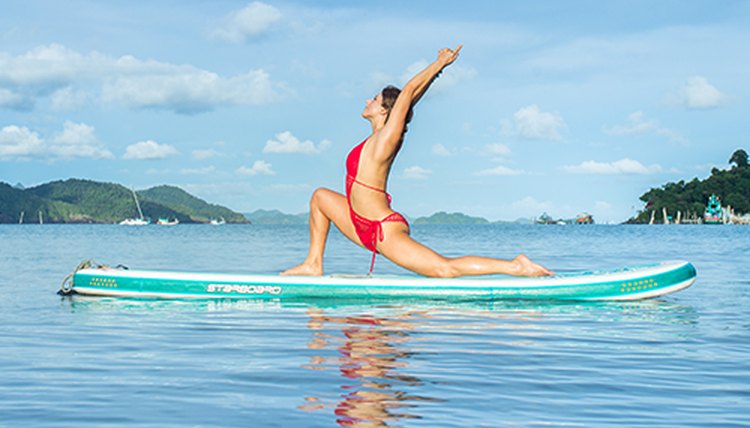
Dashama Gordon
3. Bow Pose (Dhanurasana)
Bow pose strengthens the back of your body and increases spinal flexibility. This version also opens your shoulders and stretches your torso. HOW TO DO IT: Start lying on your belly and reach back for your ankles or shins and lift your chest gently as you pull your heart up toward the sky and press your toes to the heavens. Gaze can be upward or forward, depending on your neck flexibility. Hold for five to 10 breaths and repeat three times.
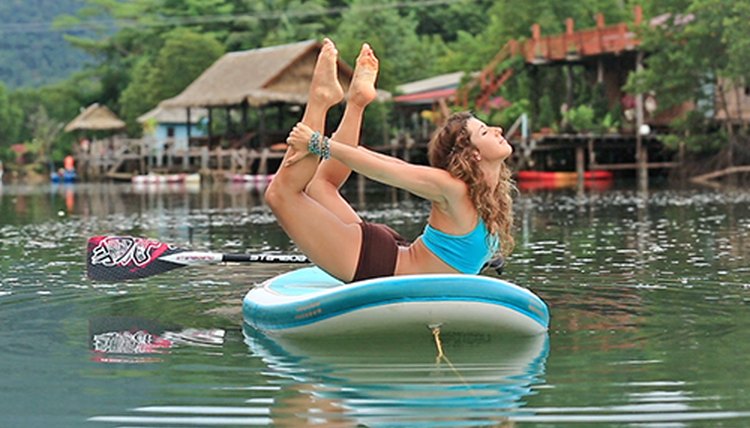
Dashama Gordon
4. Monkey Pose (Hanumanasana)
Yogic splits are great for opening your hamstrings, inner thighs and hip extensors. If you haven't been able to do splits so far, you'll want to focus on stretching those areas of your body first before going into this intermediate pose. On the paddleboard, you may wish to stabilize yourself with hands positioned on the board. If you feel stable, increase the challenge by reaching your hands toward the sky. HOW TO DO IT: With one leg in front and one behind, lengthen your spine and keep your hips as square to the front of the board as possible to maintain a balanced, even stretch. Hold for five to 10 breaths and repeat on the other side.
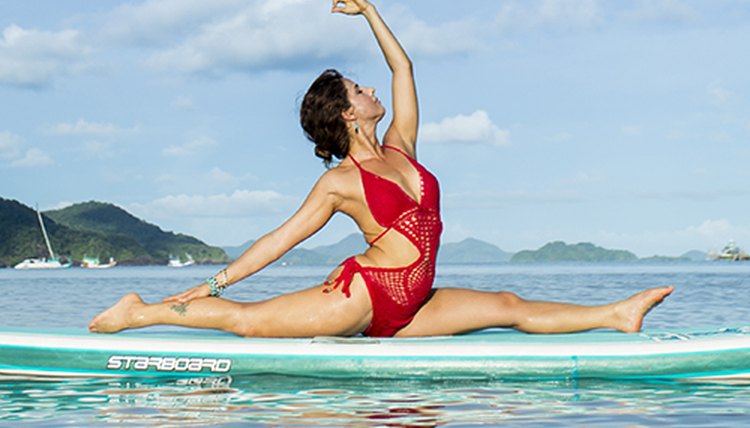
Dashama Gordon
5. Camel Pose (Ustrasana)
Camel pose is great for increasing spinal flexibility and core and leg strength. But be sure to counterbalance this pose with a restorative forward bend like child’s pose. HOW TO DO IT: Begin by rooting your knees, shins and the tops of your feet deeply into the board. If you don’t yet have the deep spinal flexibility, flip your toes under to lift your ankles higher. Engage your core and shift your hips slightly forward. If your neck is flexible, release your head back. Otherwise, look forward. Remain in the pose for five to 10 breaths. Place your hands on your lower back and rise slowly back to the starting position.
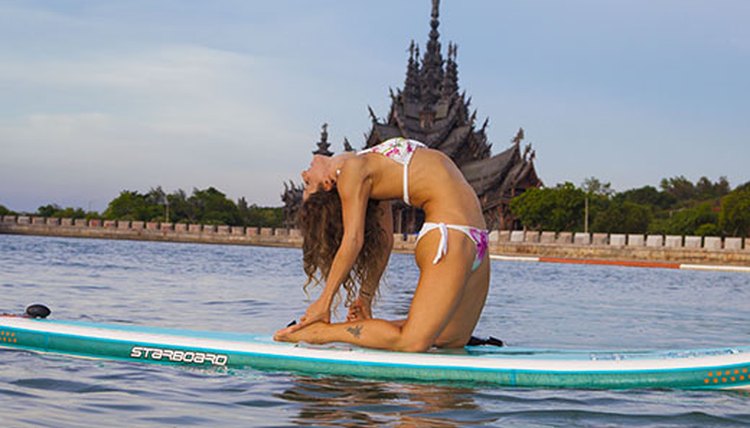
Dashama Gordon
6. Side Plank (Vasisthasana)
This pose will challenge your core strength and balance. HOW TO DO IT: For beginners, start on your side with the bottom knee down or the top leg bent to stabilize yourself on the board. Rooting down through your right palm and lifting your hips toward the sky, engage your oblique strength and lengthen the left side of the body as you make a rainbow arch with your body. Feet are either positioned heel to toes or, for a more advanced option, can be stacked. Your upper arm can be extended straight up over your head or on your left hip. Hold for five to 10 breaths. Repeat on the other side.
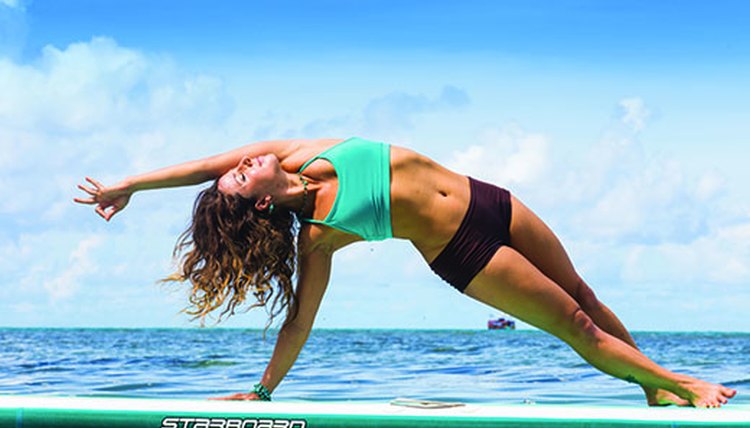
Dashama Gordon
7. Warrior II (Virabhadrasana II)
All standing poses require strength and balance, but on a floating platform, it becomes an additional challenge. Being fluid and strong allows you to balance better. HOW TO DO IT: Position yourself with the right leg forward, knee bent at 90 degrees and left leg back and straight. Feet are perpendicular -- your front toes point forward and your heel lines up with back arch. Your tailbone is tilted down and your spin is long. Spread your arms wide apart and focus your gaze forward past the front middle finger. Sink the hips low as you track your right knee forward. Hold for five to 10 breaths and repeat on the other side.
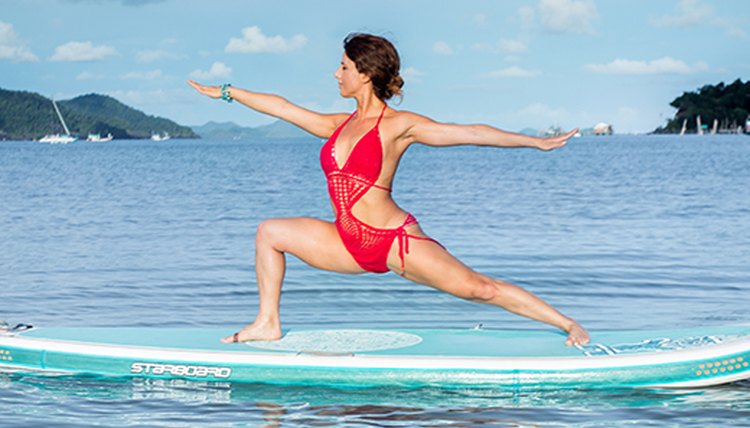
Dashama Gordon
8. Hollow Back Wheel (Hollow Back Chakrasana)
This is an advanced yoga pose that requires deep shoulder and spinal flexibility, stabilization and core and leg strength. If you're not ready for this, try either traditional wheel pose or bridge pose. Counter the pose by squeezing your knees into your chest. HOW TO DO IT: Start in wheel pose, and then lower onto the elbows one at a time so the forearms are on the board and palms come together. To alleviate pressure, lift your heels to tilt the tailbone down and create space in the lower back. Take a few breaths. To come out, flip the palms one at a time to face down. Press back to full wheel then lower to your back.
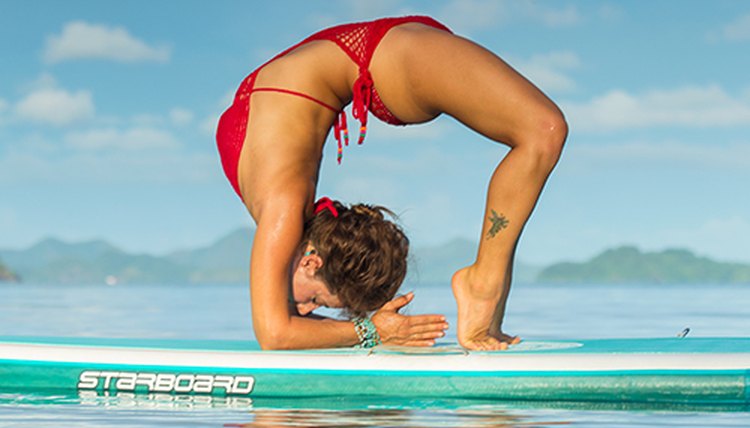
Dashama Gordon
9. Extended Hollow Back Wheel (Extended Hollow Back Chakrasana)
This is a variation of the pose on the previous slide. You get into it the same way as that version. The difference is how you extend a leg. HOW TO DO IT: Step one foot to the center of the board to stabilize yourself. From there, try it with a foot flat (the more grounded version) or with the heel lifted to get greater extension (if you're able to balance). Bend the opposite knee and lift that knee toward the sky. When you feel stable, extend the leg, pointing your toe toward the sky. Hold for five to 10 breaths, and then lower the leg down and switch sides. Lower yourself back down to the board.
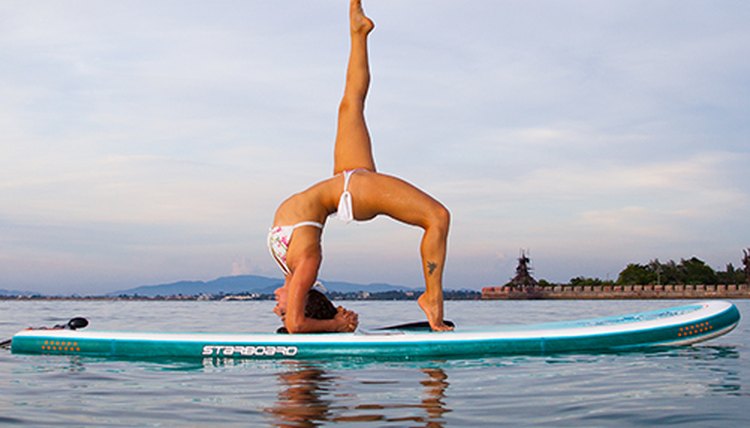
Dashama Gordon
10. Chin Stand Scorpion (Shalabhasana Vrschikasana)
This is another advanced pose that challenges balance, flexibility, focus and strength. HOW TO DO IT: Start in chatarunga, which is like plank position with elbows bent 90 degrees and squeezed into your side. From there, shift your weight forward and place your chin down on the board, gaze forward down the tip of your nose. Raise one leg at a time, grounding into your palms and engaging your core. Then lift both legs toward the sky. Squeeze your elbows into your ribs, lengthen your spine and bend your knees, allowing your toes to fall toward the crown of your head. Hold for a few breaths then slowly lower one leg at a time back to chatarunga.
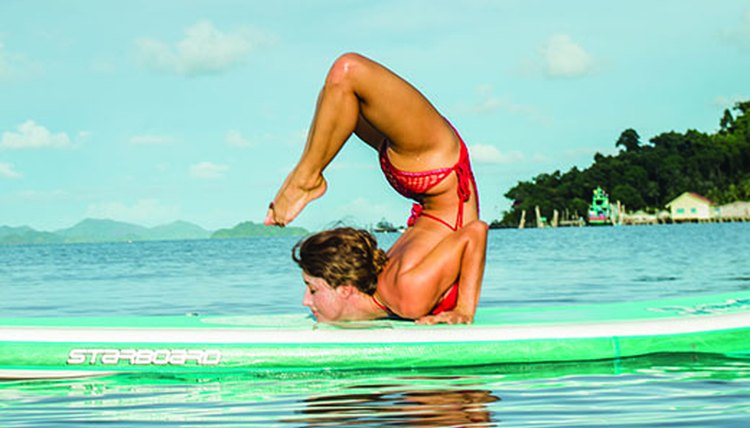
Dashama Gordon
11. Scorpion Pose (Vrschikasana)
This is one of the most advanced inversions in yoga and requires great balance, core strength, stabilization, spinal flexibility and focus. You can build up to this pose by practicing dolphin pose or other forearm balances. HOW TO DO IT: Starting on your hands and knees, place both of your forearms flat on the board with elbows and wrists shoulder-distance apart. Extend your knees straight so you are in a forearm version of downward-facing dog. Walk your feet toward your face. Lift one leg at a time or, if you can, both of them together, bend your knees and point your toes toward your head. Remember to breathe. To come down, lower one leg at a time and rest in child’s pose.
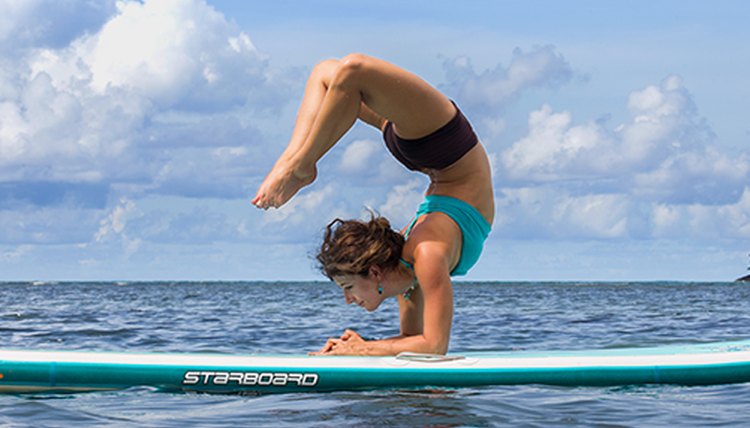
Dashama Gordon
12. One-Legged King Pigeon (Eka Pada Rajakapotasana)
This is an advanced version of a common hip opener, pigeon pose. HOW TO DO IT: Start with your right knee forward and bent. Your right foot is pulled in toward your left hip and your left leg is extended straight back behind you. Rest your palms on the board in front of you. Bend your left knee while you stabilize yourself with your right hand near your right hip. Reach your left hand back for your left foot. If you can, relax your head back until the crown of your head rests on the sole of your foot. Hold for five to 10 breaths, and then release slowly. Repeat on the other side.
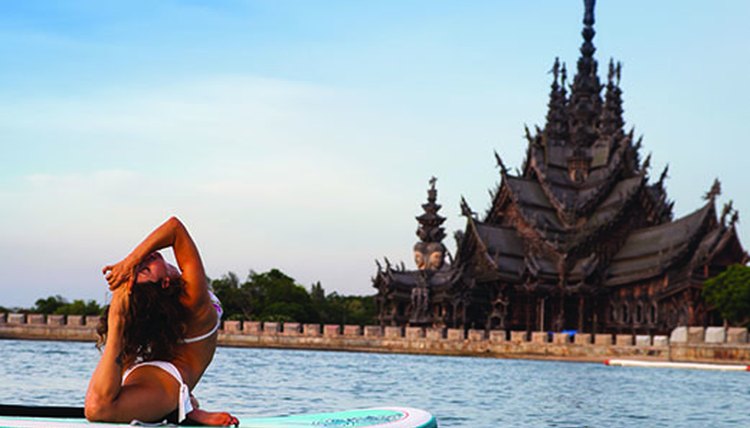
Dashama Gordon
What Do YOU Think?
Paddleboard yoga can take your practice to a much deeper level because of the additional core strength, balance and stabilization required. Just like anything, it takes time to master, so don’t be hard on yourself if you can’t do a pose on a floating board. Life is a journey and not a destination. Enjoy the journey! And be sure to tell us about it. Are you a yoga practitioner? If so, what type of yoga do you practice? Have you tried paddleboard yoga? What did you think? What are your favorite poses to do on your board? What was the hardest part of mastering it?
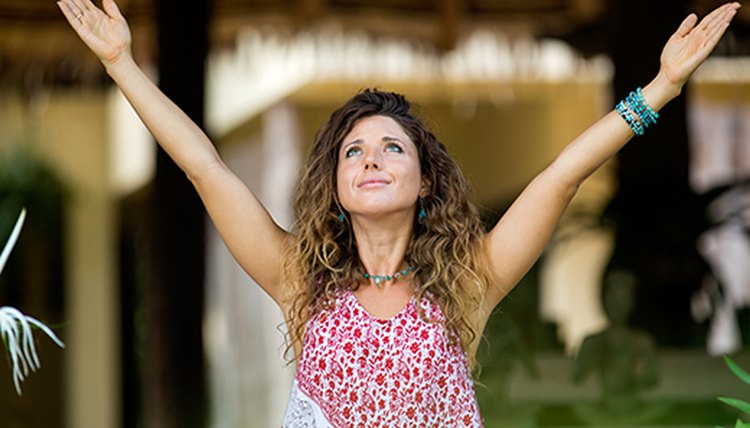
Dashama Gordon
References
Writer Bio
Dashama is the founder of Pranashama Yoga Institute, certifying yoga teachers internationally, and the pioneer credited with starting the paddleboard yoga trend. She is also the producer of more than 25 yoga instructional DVDs, author of "Journey to Joyful" and several other health and yoga related books. One of the first yoga teachers on Youtube, Dashama's 30 Day Yoga Challenge went viral in 2009 reaching millions of people world wide and started the online social media yoga challenge trend.
